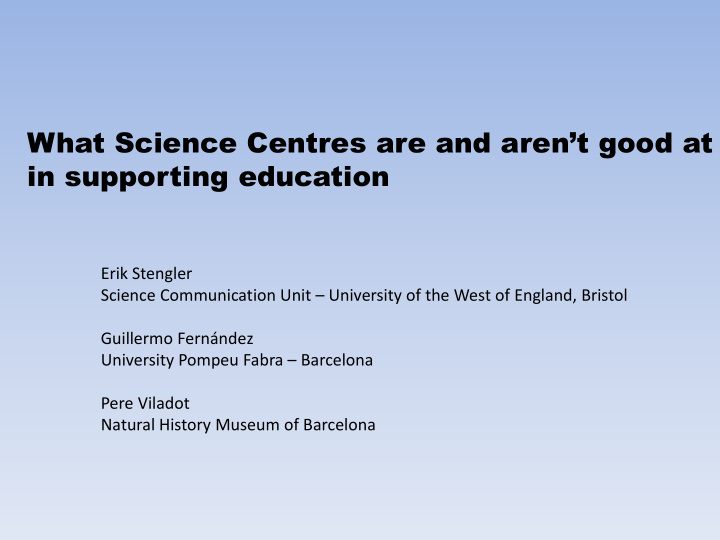



What Science Centres are and aren’t good at in supporting education Erik Stengler Science Communication Unit – University of the West of England, Bristol Guillermo Fernández University Pompeu Fabra – Barcelona Pere Viladot Natural History Museum of Barcelona
Premise: Science Centres find themselves in an identity crisis, in stagnation. After a period of quick growth and immense popularity, Science Centres now need to find their “unique selling point” to their two main audiences: • Family public • School visits
Following trends, the winds that blow: From (naïve) exhibition design: New technologies Museum becomes obsolete in months
The winds that blow: From Science Education: Hands-on/interactivity Museum becomes a button pushing exercise
The winds that blow: From STS Dialogue Museum becomes the museum of events and activities Do we need a museum for this? (Owen & Stengler, 2015)
The winds that blow: From the market : Entertain children
The winds that blow: From the market : Entertain children Science communication becomes all about FUN Stengler, Lyons and Fernandez (2013)
Ranchi Science Centre (INDIA) Dharwad Regional Science Centre (INDIA)
>200 in USA
Science communication becomes all about FUN Deterrent for scientists to engage Wrong message about science Wrong message about children Wrong message about education Displaces inquiry based learning while Science Centres are a valued resource for science education (example with Physics and Astronomy – Tee & Stengler 2015)
Core business : Exhibitions “that provide a unique, intrinsically motivating intellectual/learning experience ” Not just exhibitions/programmes with a Mary Poppins approach (Ucko 2013) Since In their beginnings, Science Centres were considered ideal for inquiry based learning (Allen 2004) and a time-consuming constructivist approach to learning (Rennie and Johnston 2004)
Tool: Museographic language Analogy with cinematographic language: • Story (not a patchwork of exhibits) • Director (expert in this language) •“not (necessarily) for children only” • ...
References: Ucko, D. A., 2013, Science Centers in a New World of Learning. Curator, 56, 1, pp 21-30. Allen, S. 2004, Designs for Learning: Studying Science Museum Exhibits That Do More Than Entertain. Science Education - Supplement: In Principle, In Practice: Perspectives on a Decade of Museum Learning Research (1994 – 2004).DOI 10.1002/sce.20016 Owen, H. and Stengler, E. (2015) Do science centres really engage in dialogue with the public? The Pantaneto Forum, 59. Rennie , L. J., and Johnston, D. J., The Nature of Learning and Its Implications for Research on Learning from Museums. Science Education - Supplement: In Principle, In Practice: Perspectives on a Decade of Museum Learning Research (1994 – 2004).DOI 10.1002/sce.20017 Stengler, E., Lyons, M. y Fernandez, G. (2013) Is Science Fun? Think again. The Dangers of Conveying the Message that Science is Fun. SiS Catalyst and EUCU.NET joint conference Truth or Dare? Dilemmas in Science Communication with Children. Lodz, Poland, 23-26 October 2013.
Recommend
More recommend